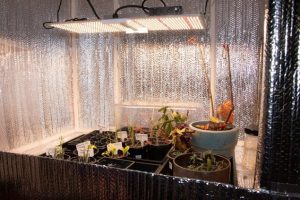As I sit and watch the snow fall outside my window, I am forcibly reminded that, unlike many places in California, it is NOT time to plant my spring and summer vegetable garden here in the foothills of the Sierra Nevada. Does that mean no fresh tomatoes until sometime in August? Perish the thought! It is time to learn about grow boxes and starting seeds indoors.
Seeds need a few things to do well indoors. Water, soil and light of course, but soil temperature and the right kind of light are critical. While some seeds may germinate in darkness, the minute that tiny plant pokes its head up above ground it is screaming for sunlight. So what is a good place to start if you want to avoid nursery prices for truly fresh veggies? While you can start veggies on a sunny windowsill, my experience is that they are always extremely leggy and don’t do that well. Add a heat mat and they will start better, but they are still all stretched out.
But don’t give up yet. You can get a full-daylight fluorescent light placed really close to the plants. Include a seed-starting flat, and pretty inexpensively, you have a low-end grow box. With a heat mat you are really in business but for my foothill garden, that still won’t get me tomatoes in an acceptable time. The problem is that the normal fluorescent lights are not enough to sustain good vegetative growth to truly extend the season and get me timely tomatoes and, after all, what is a good BLT without great tomatoes?
My answer is PVC. In addition to water lines, I build all sorts of things for my garden from PVC pipe: low tunnels, tomato cages, bird netting frames for my low-pruned fruit trees, berry vines and now a 3x4x4 grow box to start my season outright.
Building the box was fairly simple: using ¾ inch PVC pipe and side outlet elbows at the corners with a few trees thrown in for intermediate bracing, the frame goes together easily. It is very lightweight so it can be moved easily, and the size adjusted to fit the space you have available. This is a pretty easy DIY project. To cover it I used reflective roll insulation which is readily available and helps keep the heat in. I put this on with the tape the insulation company makes specifically for this purpose. There are less expensive ways to cover this, like Mylar, which is reflective, or a white painter cardboard. But my basement is cold in the winter and I wanted a little insulation. I also use a 70 degree heat mat for the same reason.
As you may have noticed I tend to overbuild, it is something my friends find amusing. This project was no exception. I bought a full spectrum LED light in the name of science and then gave it to my wife for Christmas. (How is that for covering all your bases?) It does not need to be as close to the plants as the florescent lights and it will allow you to cover vegetative and blooming cycles as well as seed starting. Hopefully adding the vegetative capacity will really give me a jumpstart on tomato season.
There are a lot of other uses for a grow box as well. We use it for certain cuttings like lavender or begonias. My wife’s African violet started blooming like crazy in there. Light, humidity, and warmth, what more could a plant want while it is snowing outside?
If you have any questions that are garden related call the University of California Master Gardeners hotline at (209) 533-5912 or email us at mgtuolumne@ucdavis.edu. From rainwater tanks to drought-resistant plants we can help you find an answer
Jim Bliss is a University of California Cooperative Extension Master Gardener of Tuolumne County.
UCCE Master Gardeners of Tuolumne and Calaveras Counties can answer home gardening questions. Call 209-533-5912 or fill out our easy-to-use problem questionnaire here. Check out our website here. You can also find us on Facebook.

